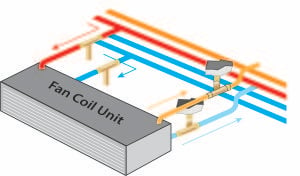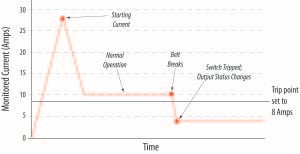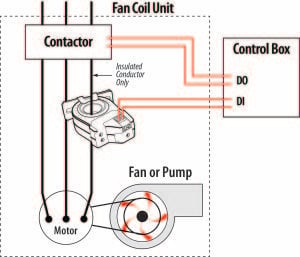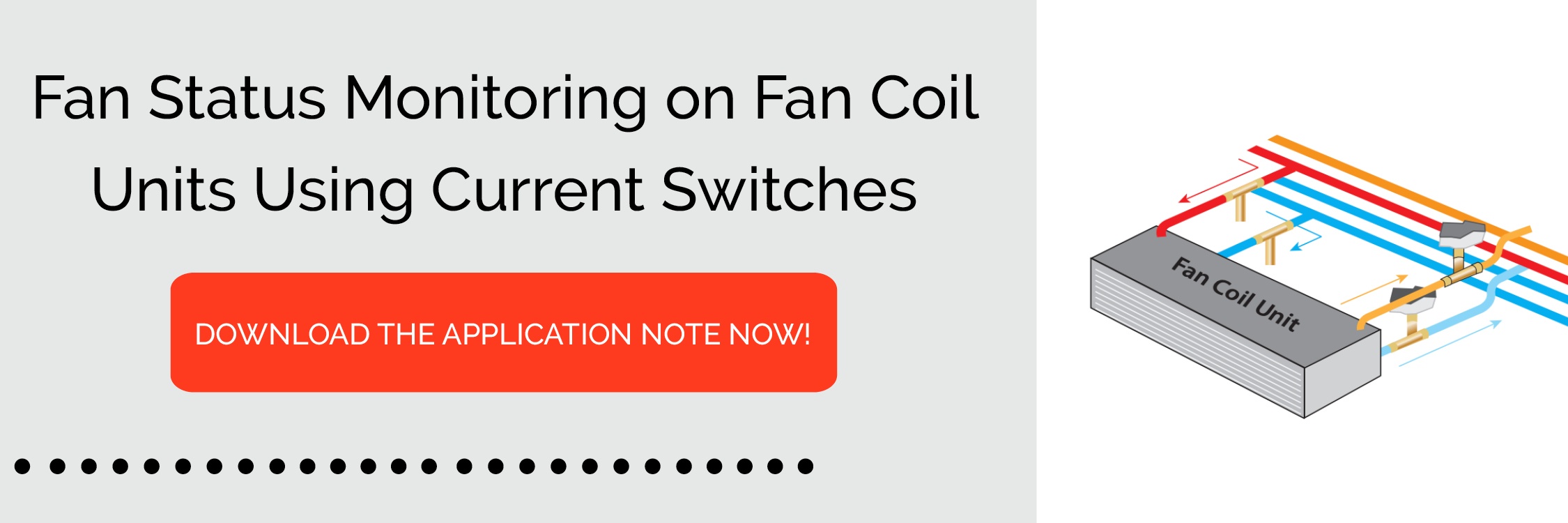Fan Coil Units: Advantages of Their Use with Current Switches

What is a Fan Coil Unit and how does it work?
A fan coil unit (FCU) is a device composed of a fan and either a heating or cooling element called a coil. Indoor air moves over the coil, which either heats or cools the air based on the coil type, then pushes the air back out into the room.
Fan Coil Unit Diagram

As demonstrated in the fan coil unit diagram, a cooling coil is used to cool an area without connecting to duct work. On the left hand side, the hot air enters the device and moves across the cooling element. On the right hand side, the cool air is ejected. In a fan coil unit that employs a heating coil, the direction of the heat is the inverse, with hot air being pushed out of the fan coil unit.
Theory of Current Sensor Operation

In a constant volume fan motor, about 60% of the energy consumed is used to move the air, leaving 40% or less of the energy consumed to turn the motor. When the fan motor has a mechanical failure or belt breakage the motor amperage drops roughly 60%.
Current switches monitor fan motor status by reading the amperage in the conductor supplying the motor. A mechanical failure in the motor causes a drop in amperage that is instantly detected by the current switch, which sends an alert to the control system. Current switches provide the most reliable and cost effective way to monitor positive proof of flow for fan motors in fan coil units (FCUs).
The Traditional Approach: Differential Pressure Switch Technology
Differential pressure (DP) switches monitor fan motor status by sensing the difference in pressure between the supply and discharge sides of the fan. This is accomplished by penetrating the duct work and installing pick-up tubes on both sides of the fan. The tubing is connected to a mechanical switch that has a single adjustable trip point. When a change in the differential pressure between the pick-up tubes is detected, the switch opens or closes accordingly.
The technology is effective, but it has drawbacks. DP switches are mechanical, and, therefore, require routine service. Clogged tubing and pitted or corroded contacts make the switch unable to respond to an alarm condition. Additionally, the pick-up tubes are external, and can be subject to damage during installation of the FCU. Finally, standard industry DP switches do not always have sufficient sensitivity to monitor systems with low air flow, such as those found in fan coil units.
Current Switches for Fan Coil Units: Application Advantage
Fan coil units put out a much lower air volume than packaged air handling units, making DP switches undesirable due to low accuracy at low air flow rates. So rather than measure flow using differential pressure, an installer can monitor the amperage draw on the motor to determine its operation status.
 Current switches have a low turn-on current and can detect a motor’s amperage down to 0.15 A (on select models), making them ideal for the low air flow of fan coil units. Multiple wraps of the conductor through the current switch center window allows them to monitor conductors with even lower amperages.
Current switches have a low turn-on current and can detect a motor’s amperage down to 0.15 A (on select models), making them ideal for the low air flow of fan coil units. Multiple wraps of the conductor through the current switch center window allows them to monitor conductors with even lower amperages.
Current switches are 100% solid state, with no mechanical parts to fail or to require service beyond a one-time calibration at the time of installation. A self-calibrating feature (on select models) reduces the setup time even further and ensures reliable and accurate readings. Current switches are installed on the conductors inside the FCU, so they are protected from damage during FCU installation.
Take a closer look at the H808
Interested in learning more about Current Switches? Contact a current monitoring specialist today: 800.354.8556 or at sales@veris.com.
The information provided herein is intended to supplement the knowledge required of an electrician trained in high voltage installations. There is no intent to foresee all possible variables in individual situations, nor to provide training needed to perform these tasks. The installer is ultimately responsible for ensuring that a particular installation remains safe and operable under the specific conditions encountered.





